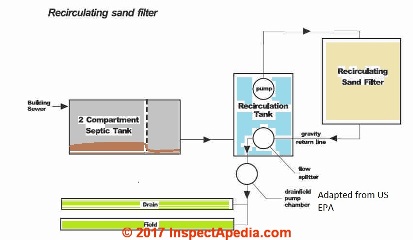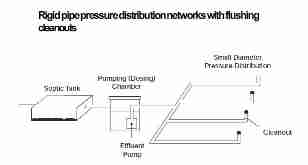 Septic Effluent Dosing Control for Septic Media Filters
Septic Effluent Dosing Control for Septic Media Filters
- POST a QUESTION or COMMENT about septic effluent dosing control of septic media systems
Dosing Septic Systems:
This document discusses the Septic Effluent Dosing Control for Septic Media Systems. When using a septic media filter system, effluent treatment is by both actual filtration and ultimately by a biochemical process as the filter "matures" and includes its own biomass.
Both natural media filter septic systems (such as sand, gravel, or peat) and synthetic media filter septic systems (foam cubes, glass, slag) are used, and both single-pass and effluent recycling systems may be employed.
InspectAPedia tolerates no conflicts of interest. We have no relationship with advertisers, products, or services discussed at this website.
- Daniel Friedman, Publisher/Editor/Author - See WHO ARE WE?
Septic Effluent Dosing Control for Septic Media Systems
A septic effluent dosing system which passes on effluent at the appropriate rate is part of the design of a media filter septic system. Dosing may be controlled by sensors and an electric pump or by gravity and a bucket tipping system.
Septic effluent dosing control is achieved using pumps controlled by timers and level sensors which assure that effluent is applied in sufficiently small doses to permit effective treatment.
Septic Dosing Systems, Pressure Dosing or Gravity Dosing
Dosing systems permit the septic system drain field to rest
between effluent doses and, depending on design, may alternate use of drainfield sections. Two broad types
of dosing systems are Gravity-Dosing (effluent flows from an effluent tank to the absorption system by gravity) or
Pressure-Dosing (effluent is pumped from a dosing chamber to the absorption field).
See Gravity Dosing Septic Systems and Pressure-dosed Drainfield Septic Systems for details about dosing system design, installation, and product alternatives for each of these dosing system types.
Septic Dosing System Regulations
Ohio - TIMED DOSING SYSTEM SEPTIC DESIGN SPECIFICATIONS [PDF]
Filters, Septic Filters & Wastewater Treatment Systems
- Amphidrome from F.R. Mahoney, Associates, is a "sequencing batch reactor" or effluent recycling system (approved in MA) cycling effluent between the septic tank and a reactor vessel.
- AdvanTex- Onsite Wastewater Treatment Systems from Orenco uses a textile filter in a fiberglass basin.
- Biomicrobics wastewater treatment include BioSTEP, a screened pumping system, BioBarrier membrane bioreactor (MBR) which produces ultra-clean effluent Lixor, their submerged aeration system, SaniTEE wastewater screens and other wastewater treatment systems and products.
- Biocycle Wastewater Treatment a BioCycle Unit, Tertiary Polishing Filter and Monitoring System.- Ireland
- Bioren & Living Filter alternative wastewater treatment systems - Mass. USA
- Bioclere from AquaPoint (MA) is a trickle-filter effluent treatment system
- JET INC., 750 Alpha Dr., Cleveland OH 44143 USA, Tel: 440-461-2000, email: email@jetincorp.com Website: jetincorp.com retrieved 2016/05/15, original source, Ohio health department, U.S.A., http://www.odh.ohio.gov/~/media/ODH/ASSETS/files/eh/sts/P-Jet-1500%20Series%20BAT%20Media%20Plants-Ownman-952%20UV
see BAT MEDIA SEPTIC PLANTS - biologically accelerated treatment septic systems - Peat Filters for septic effluent treatment, University of Minnesota Information Article on Peat Systems
- Ruck systems (in MA) "Traditional RUCK- [Residential Septic] Systems are passive innovative septic systems that are designed to remove nitrogen and provide excellent treatment for an on site septic system." Commercial products are also available. This is an in-ground filter system installed between the septic tank and the absorption field.
- SeptiTech Residential and Commercial Wastewater Pretreatment Systems include a fixed film effluent trickling filter and a patented effluent treatment media.
- Waterloo biofilter trickle type wastewater filter and systems using aeration combined with foam filter media; effluent is sprayed over foam.
...
Continue reading at FOAM CUBE SEPTIC MEDIA FILTERS or select a topic from the closely-related articles below, or see the complete ARTICLE INDEX.
Or see these
Recommended Articles
- MEDIA FILTER SEPTIC SYSTEMS - home
- BAT MEDIA SEPTIC PLANTS
- DOSING CONTROL for SEPTIC MEDIA SYSTEMS
- FOAM CUBE SEPTIC MEDIA FILTERS
- PEAT SEPTIC MEDIA FILTERS
- RUCK® SEPTIC MEDIA FILTER SYSTEMS
- SAND SEPTIC MEDIA FILTERS
- SANDY SOIL SEPTIC DESIGNS
- SEPTIC MEDIA FILTER CAPACITY & MAINTENANCE
- SEPTIC MEDIA FILTER SOURCE LIST
- SEPTIC MEDIA FILTER SYSTEM OPERATION
- SINGLE PASS vs RECIRCULATING SEPTIC MEDIA FILTER DESIGNS
- TEXTILE SEPTIC MEDIA FILTERS
- TYPES of SEPTIC MEDIA FILTER MATERIALS
Suggested citation for this web page
DOSING CONTROL for SEPTIC MEDIA SYSTEMS at InspectApedia.com - online encyclopedia of building & environmental inspection, testing, diagnosis, repair, & problem prevention advice.
Or see this
INDEX to RELATED ARTICLES: ARTICLE INDEX to SEPTIC SYSTEMS
Or use the SEARCH BOX found below to Ask a Question or Search InspectApedia
Ask a Question or Search InspectApedia
Try the search box just below, or if you prefer, post a question or comment in the Comments box below and we will respond promptly.
Search the InspectApedia website
Note: appearance of your Comment below may be delayed: if your comment contains an image, photograph, web link, or text that looks to the software as if it might be a web link, your posting will appear after it has been approved by a moderator. Apologies for the delay.
Only one image can be added per comment but you can post as many comments, and therefore images, as you like.
You will not receive a notification when a response to your question has been posted.
Please bookmark this page to make it easy for you to check back for our response.
IF above you see "Comment Form is loading comments..." then COMMENT BOX - countable.ca / bawkbox.com IS NOT WORKING.
In any case you are welcome to send an email directly to us at InspectApedia.com at editor@inspectApedia.com
We'll reply to you directly. Please help us help you by noting, in your email, the URL of the InspectApedia page where you wanted to comment.
Citations & References
In addition to any citations in the article above, a full list is available on request.
- New York State Department of Health, APPENDIX 75-A WASTEWATER TREATMENT STANDARDS - INDIVIDUAL HOUSEHOLD SYSTEMS , [PDF] New York State Department of Health, 3 February 2010, retrieved 3/1/2010, original source: https://www.health.ny.gov/regulations/nycrr/title_10/part_75/appendix_75-a.htm
- "Septic Tank/Drainfield System Fact Sheet", Utah Department of Environmental Quality, Division of Drinking Water, Source Protection Program - (801) 536-4200 Division of Water Quality - (801) 538-6146 Sonja Wallace, Pollution Prevention Coordinator - (801) 536-4477 Environmental Hotline - 1-800-458-0145 - Original source: http://www.drinkingwater.utah.gov/documents/spec_services/pollution_prevention_septic_tanks.pdf
- New York State Wastewater Treatment Standards - Individual Household Systems, Appendix 75-A (1990), Public Health Law 201(1)(1).
- Advanced Onsite Wastewater Systems Technologies, Anish R. Jantrania, Mark A. Gross, CRC Taylor & Francis, 2006 ISBN 0-8493-3029-7
- Our recommended books about building & mechanical systems design, inspection, problem diagnosis, and repair, and about indoor environment and IAQ testing, diagnosis, and cleanup are at the InspectAPedia Bookstore. Also see our Book Reviews - InspectAPedia.
- In addition to citations & references found in this article, see the research citations given at the end of the related articles found at our suggested
CONTINUE READING or RECOMMENDED ARTICLES.
- Carson, Dunlop & Associates Ltd., 120 Carlton Street Suite 407, Toronto ON M5A 4K2. Tel: (416) 964-9415 1-800-268-7070 Email: info@carsondunlop.com. Alan Carson is a past president of ASHI, the American Society of Home Inspectors.
Thanks to Alan Carson and Bob Dunlop, for permission for InspectAPedia to use text excerpts from The HOME REFERENCE BOOK - the Encyclopedia of Homes and to use illustrations from The ILLUSTRATED HOME .
Carson Dunlop Associates provides extensive home inspection education and report writing material. In gratitude we provide links to tsome Carson Dunlop Associates products and services.


